
ladies and gentlemen, we are floating in space.
the big. the bad. the MEGA. architecture as a global condition.
1.19.2007
1.15.2007
12.07.2006
PANDEMIC/antiPANDEMIC
link for presentation: video of AIDS attacking a human white blood cell.
PANDEMIC
The vastness universe is built upon microscopic particles. Life on Earth is little more than a series of perfect combinations of these particles, and death on Earth is a result of the destruction or incapacitation of the most vital of these particles.
Often, death may come from the inside out and grow from microscopic to MEGA. I'm concentrating on this idea: the MEGA effect of something that is entirely microscopic. This is a storm that arises from inside of people, from a cellular level, and overtakes their bodies and eventually claims their lives, and on the cellular level it spreads throughout the population, claiming lives in masses.
This is the AIDS PANDEMIC. This project focuses on the battle against a MEGA condition that is currently inhabiting an estimated 35 million lives. (To see a more detailed post showing mappings regarding the AIDS-infected population and the availability and prevalence of treatments, click here).
[[any images may be clicked for a larger view]]

The mapping on the left shows a decrease in the population when AIDS cases
are subtracted out (those uninfected are portrayed by the white mesh).
The map on the right shows (in blue) the areas where more than 10%
of the population is able to receive the treatment medications.
The network in the map on the right is the corporate, production and sales
network of Glax0SmithKline, the company that makes the drugs to treat AIDS.
When these areas of treatment are pushed together along with their GSK manufacturing plants, you can see from this MEGAcontinent that many of the manufacturing plants are located outside of areas that receive the bulk of the treatment. This means that while Jamaica, for instance, might have a plant to produce these drugs, they are being sold to other countries.

antiPANDEMIC
If architecture was the cure for AIDS, what would it be?
What is AIDS, formally and conceptually? This video shows the AIDS virus infecting a lymphocyte (human white blood cell). The virus enters the cell, causes it to empty its contents, and then uses it as a host to do the same to other lymphocytes, and so on. These still images of the video should give an understanding of what is happening.



The drugs produced by GSK (primarily lamiduvine and zadovudine) help to weaken the host cell and slow the spread of AIDS.
Attack/counterAttack.
When AIDS spreads slowly, it prolongs the life of the AIDS patient, increasing chances that the patient will be alive when the cure might be discovered. The smallest chemical bonds in a pill has the power to prolong the lives of 35 million people; the problem is that they can't all get it.
 While the problem is very heavily political and economic, if there were an efficient and effective way to spread prevention methods and knowledge, care and comfort, and the medications themselves, political and economic support from governments and organizations could be more likely.
While the problem is very heavily political and economic, if there were an efficient and effective way to spread prevention methods and knowledge, care and comfort, and the medications themselves, political and economic support from governments and organizations could be more likely.I could not help but think of Archigram's Plug-In City; towers of units that are transported between each other on a mega network. These are some conceptual collages of Archigram's work combined with my mappings.


What if architecture was an infection?
What if healthcare was flexible? What if it were made up of parts - cells - that could go virtually anywhere, and contain what is needed to combat AIDS? These cells could "plug" into certain locations, serve their purposes, and then be taken away to be refilled, repaired, or deconstructed. What if architecture took on the form of the AIDS virus for the purposes of fighting the AIDS virus, infecting the cities with health from the inside out and then passing it onto other cities?
a first attempt at a city scale





These images depict the AIDS treatment cells being "plugged" into a city.
MEGAhealth
I propose a hierarchical network of the GlaxoSmithKline company's AIDS division. From the headquarters (located in London) comes knowledge, technology, and the patent on the drugs. All of these are intangible and immaterial. These things reach the manufacturing sites, hubs, where the immaterial network is materialized. Cells are constructed here, as well as the drugs and equipment to go in them. Hospital rooms, information cells, AIDS pharmacies and AIDS testing supplies are all made and contained into the cells.

MEGAhealth can be applied in virtually any architectural, geographical, or sociopolitical situation. It is to be versatile and flexible and free. I chose these three sites for the following reasons:

1. Cape Town, South Africa is already a site for a GSK manufacturing plant, but I believe it is a good hub because it has the best resources in the southern region of Africa. The transportation and healthcare infrastructures are well in tact. There is a large amount of class separation, as in most cities in Africa, but MEGAhealth is made to go anywhere, for anyone. Cape Town will serve as the hub for these purposes.
2. Mesaru, Lesotho is the capital of Lesotho. It is small and the poverty level is high, not to mention a very high demand for AIDS treatment. It is very accessible - with a main railroad, a river, and an international airport. The healthcare system is out of date and low on funding.
3. Omusati, Namibia is an area in the wildest part of Namibia. There is a freight road that passes through it, crossing the entire country's width and connecting Omusati to a port. AIDS is prevalent in this area, and there is one missionary-run hospital with very out-dated technology.
The form I came up for the manufacturing plant with is made to mimic a cell in its lysing state. The contents are maintained within walls, and the contents spill out to go infect the rest of the city and the other cities.




There are roads or railroads that come out from the plant. The idea is that these pods can infiltrate the modern transportation processes, and the transportation network is somewhat virtual in that sense.

This virtual meganetwork - the bloodstream on which the treatment travels - is made up of the tiny components of modern transportation modes.

These units are shown here plugged into (first) a hospital in Cape Town, (second) a hospital in Mesaru, and (third) a framework built to contain them in a place (Omasuti) where there is no means to contain them.



These images are the small parts of the whole: particles causing a MEGA effect. In the same way that AIDS conquers the body and spreads across the globe, the GSK network might conquer a city and spread as well - spreading preventional knowledge, treatment, and care and comfort to those who cannot currently benefit from these things.
This is fighting the PANDEMIC with an antiPANDEMIC.
a first attempt at a city scale





These images depict the AIDS treatment cells being "plugged" into a city.
MEGAhealth
I propose a hierarchical network of the GlaxoSmithKline company's AIDS division. From the headquarters (located in London) comes knowledge, technology, and the patent on the drugs. All of these are intangible and immaterial. These things reach the manufacturing sites, hubs, where the immaterial network is materialized. Cells are constructed here, as well as the drugs and equipment to go in them. Hospital rooms, information cells, AIDS pharmacies and AIDS testing supplies are all made and contained into the cells.

MEGAhealth can be applied in virtually any architectural, geographical, or sociopolitical situation. It is to be versatile and flexible and free. I chose these three sites for the following reasons:

1. Cape Town, South Africa is already a site for a GSK manufacturing plant, but I believe it is a good hub because it has the best resources in the southern region of Africa. The transportation and healthcare infrastructures are well in tact. There is a large amount of class separation, as in most cities in Africa, but MEGAhealth is made to go anywhere, for anyone. Cape Town will serve as the hub for these purposes.
2. Mesaru, Lesotho is the capital of Lesotho. It is small and the poverty level is high, not to mention a very high demand for AIDS treatment. It is very accessible - with a main railroad, a river, and an international airport. The healthcare system is out of date and low on funding.
3. Omusati, Namibia is an area in the wildest part of Namibia. There is a freight road that passes through it, crossing the entire country's width and connecting Omusati to a port. AIDS is prevalent in this area, and there is one missionary-run hospital with very out-dated technology.
The form I came up for the manufacturing plant with is made to mimic a cell in its lysing state. The contents are maintained within walls, and the contents spill out to go infect the rest of the city and the other cities.




There are roads or railroads that come out from the plant. The idea is that these pods can infiltrate the modern transportation processes, and the transportation network is somewhat virtual in that sense.

This virtual meganetwork - the bloodstream on which the treatment travels - is made up of the tiny components of modern transportation modes.

These units are shown here plugged into (first) a hospital in Cape Town, (second) a hospital in Mesaru, and (third) a framework built to contain them in a place (Omasuti) where there is no means to contain them.



These images are the small parts of the whole: particles causing a MEGA effect. In the same way that AIDS conquers the body and spreads across the globe, the GSK network might conquer a city and spread as well - spreading preventional knowledge, treatment, and care and comfort to those who cannot currently benefit from these things.
This is fighting the PANDEMIC with an antiPANDEMIC.
12.06.2006
if we keep this up, the universe might implode
12.04.2006
i can't WAIT for my nobel peace prize
I am trucking along slowly. I have spent a lot of the weekend getting together aerial maps, pinpointing locations of hospitals, and eventually (finally) trying to model the transportation networks.
I feel a little stuck. I can probably attribute this to the fact that it's been a little frustrating because I have pretty much learned everything formZ will NOT let me do, and everything I have done has been tedious, repetitive, and has shown minimal finished product.
Because I was stuck on design, I moved back to the network to get my mind reeling. I am thinking my end piece will be a large, artistic collage which can hopefully effectively show the conversion of the GSK network from virtual (knowledge and technology) to physical (the hubs and various pods). My other option is to show an animation to examine the conceptual movement of this network, and a collage to show it virtually vs. physically at a series of scales - that one can see how this network occupies the globe, and the tiny details (which I feel are quite important) on the human scale as to how the network occupies and alters the AIDS condition existing within the population.
This system will thrive off of the ability to move, and so I have started by showing the transportation networks (regarding my sites) as they relate to the virtual network coming from London HQ.




Looking at that second image labelled "Cape Town" I have provided a vignette to show how my system will latch onto the current transportation network.

I feel a little stuck. I can probably attribute this to the fact that it's been a little frustrating because I have pretty much learned everything formZ will NOT let me do, and everything I have done has been tedious, repetitive, and has shown minimal finished product.
Because I was stuck on design, I moved back to the network to get my mind reeling. I am thinking my end piece will be a large, artistic collage which can hopefully effectively show the conversion of the GSK network from virtual (knowledge and technology) to physical (the hubs and various pods). My other option is to show an animation to examine the conceptual movement of this network, and a collage to show it virtually vs. physically at a series of scales - that one can see how this network occupies the globe, and the tiny details (which I feel are quite important) on the human scale as to how the network occupies and alters the AIDS condition existing within the population.
This system will thrive off of the ability to move, and so I have started by showing the transportation networks (regarding my sites) as they relate to the virtual network coming from London HQ.




Looking at that second image labelled "Cape Town" I have provided a vignette to show how my system will latch onto the current transportation network.

11.29.2006
research maps finally
Here is the complete city-specific research on my sites, including the major transportation networks and healthcare facilities in each place. Now I am ready to model, woopee! I'm thinking, probably just for time's sake, I'm going to just concentrate on Cape Town and the network its GSK plant would distribute to - Mesaru and Omusati - to show the network IN ACTION.


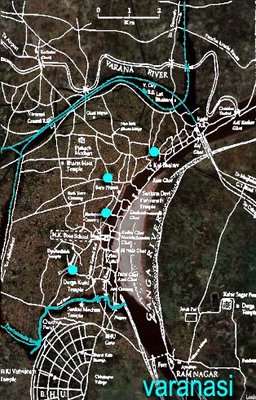


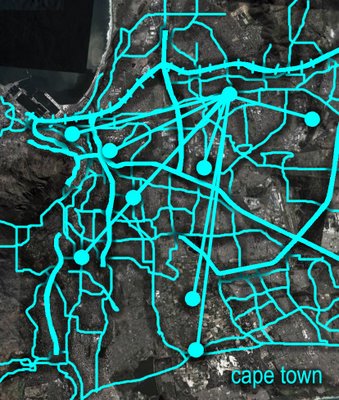

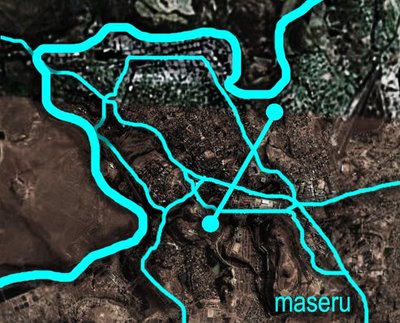
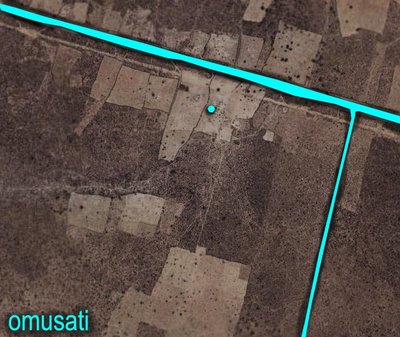









11.28.2006
bizarrchitecture
This post is really a display of the research I've been doing to find sites, and a beginning to each site's analysis. My post for Wednesday will return to the design and architecturing of the condition based on the information here and the decisions I made in this post. I KNOW I need to show you a lot of the things I describe in this text, and I WILL, but this is sort of brainstorming, analysis of what I've figured out, and the game plan.
I want to advance the idea of a healthcare system that infects civilization in the same way that AIDS has infected its populations.
A challenge I am working to address is defining the hierarchy, both architecturally and programmatically. What are the functions of the network at a series of scales?
The final and, I think, the most important challenge is picking a site or series of sites to focus on for the purposes of this project. The purpose would be to observe the system as it could exist in a variety of situations - its ability to adapt to the diverse socioeconomic, transportational, and need-based dilemmas that exist in the world is key in the proposal being successful.
_________________
I. THE HIERARCHY
Previously, I had posted this image to describe the corporate hierarchy of GSK as a network. I'm going to stick to that general concept, except instead of "distribution cities" they will be "hubs," meaning that they will contain a manufacturing and distribution plant but it does not necessarily mean a city. I'll examine in further detail.
What HQ in London contains is the knowledge, the process (and patents), and the technology to produce lamiduvine and zidovudine. London distributes these things to the separate hubs in the chosen locations. This network is virtual; it purely exists within communicative means.
The hubs contain these items which apply the virtual materials acquired from London, the production of drugs, and the production of the pods and the equipment they involve. The hubs are the plants that not only produce the treatments themselves, but they produce their methods and means, the architecture that allows the drugs to serve their purpose. It is these hubs that convert the virtual materials into physical, functional materials. The hubs will also help knowledge to build, because they will also contain research which will gain knowledge that will travel both back to the HQ and will filter down to the pods.
The wellness pods are containers that can be installed in a certain simple framework - a framework that can be expanded upon as needed and a framework that is minimally invasive. The programs of these pods include: 1. a portable pharmacy (supplying an area with the needed drugs to treat its AIDS victims, see this previously posted image). 2. A portable doctor's office (or testing lab) which will be a room that can be either set in a remote village in order to test the population for AIDS, or it can be transferred to and installed within hospitals to function as an AIDS wing or AIDS section of the hospital. 3. A portable hospital room for those extremely ill or dying or an AIDS-related infection, willing to pay extra to have the treatment and room in the comfort of their own homes (see this image from the previous post). 4. A portable information center to educate the uneducated populations on what AIDS is, how it gets contracted, and providing birth control education and STI education.
_________________
II. THE SITES
I defined the criteria for selecting manufacturing sites to this: central locations of transportation networks in their regions, areas with ample population to support and contribute to the functioning of these hubs, and regions where there is a need for AIDS treatment.
I've chosen the following sites to use as examples of a hub infecting a city.
Hyderabad, India is a logical site for a hub because it is located in a region where there is a high demand for AIDS medication, and it is a center for rail transportation in India, which is one of the main modes of transportation and shipment in India. There is also an airport in Hyderabad, which could provide an extra mode of access.
Capetown, South Africa is a center for transportation in South Africa, and also has a port which opens up new routes of transportation and distribution for AIDS treatment. It is located in close proximity to poor areas, and the port access opens up the opportunity to ship the supplies up the coast to some of the other areas in dire need of treatment. In addition to rail and port, Capetown is one of the few cities in southern Africa with an airport.
The beauty of the pod is that it can be transported and applied virtually anywhere. The following are some recipients of pods that I will use as diverse examples of how they can be applied and implemented.
Varanasi, India is one of the larger cities in India, but the crime and poverty rate are higher than the other developed cities of India. The AIDS pandemic has struck Varanasi and its surrounding towns and villages harder than the rest of India. Class separation is evident, and while health technology is up-to-date, it reaches only the fortunate few. The economy is based around ancient crafts with a few cutting-edge institutions such as Texas Instruments plants and international universities placed within its boundaries. It is connected to Hyderabad by rail.
Maseru, Lesotho is the capital of Lesotho. It is a small city of about 180,000, and is primarily comprised of low to middle class dwellings and a high unemployment rate. There is ample transportational access; it is located on the Caledon River (see map) which incidentally also runs through Capetown. There is a small international airport here, and two major highways run through it.
Omusati, Namibia is a region of Namibia with ample access to the Namibian port city of Skeletkuste. Transportation is extremely underdeveloped here, except for a massive freight road stretching across this northern wilderness. The healthcare system in this region is adequate at best; basic healthcare can be found but hospitals are few and underfunded. Like Maseru, it can be served by Cape Town as a hub.
_________________
III. OTHER AFFECTING NETWORKS
The GSK network is going to exist as a supplement to already present conditions in each location. At every site containing the location of a hub, the transportation methods and networks would be mapped and the GSK network would latch on - using the existing transportation conditions as a means transport these pods.
Hospitals that are already present - whether in cities, towns, or missionary hospitals in distant villages - will be mapped, and an AIDS wing will be made up of the aforementioned framework and placed alongside hospitals. In hub locations, the hub structures may exist as part of the hospital or an addition onto the hospital.Here I am zooming in a bit, and I've mapped the big transportation (mostly rails, that leave the city) and marked the significant hospitals.
Here I show the healthcare in Hyderabad as a network - making the hospital closest to the railroad leading to Varanasi the center of this mini-network. Perhaps this is how the GSK system can first invade the city at this point and attach onto the other hospitals via transportation, as an intra-city network.
I plan to do this level of analysis with all sites, whether they are hubs or not.
_________________
VI. FORMAL IDEAS
I found this video of the AIDS virus infecting a human lymphocyte (white blood cell). What is happening in this video, is that the clump of cells starting out at the bottom have already been infected by the AIDS virus and are attacking the lymphocyte in the middle, violating the cell wall and causing the lymphocyte's insides to come out, a process called lysing (it pays to have biologically smart friends).
Architecturally, I would like the GSK network to act as a counter-infection on the population. In the same way that the virus enters a lymphocyte, takes control of it, and causes it to attack other lymphocytes, I want the architecture to infiltrate the population, take over, and spread. My idea for this is a collapsable, expandable, and multipliable structural system.
Stay tuned for more!
I want to advance the idea of a healthcare system that infects civilization in the same way that AIDS has infected its populations.
A challenge I am working to address is defining the hierarchy, both architecturally and programmatically. What are the functions of the network at a series of scales?
The final and, I think, the most important challenge is picking a site or series of sites to focus on for the purposes of this project. The purpose would be to observe the system as it could exist in a variety of situations - its ability to adapt to the diverse socioeconomic, transportational, and need-based dilemmas that exist in the world is key in the proposal being successful.
_________________
I. THE HIERARCHY
Previously, I had posted this image to describe the corporate hierarchy of GSK as a network. I'm going to stick to that general concept, except instead of "distribution cities" they will be "hubs," meaning that they will contain a manufacturing and distribution plant but it does not necessarily mean a city. I'll examine in further detail.
What HQ in London contains is the knowledge, the process (and patents), and the technology to produce lamiduvine and zidovudine. London distributes these things to the separate hubs in the chosen locations. This network is virtual; it purely exists within communicative means.
The hubs contain these items which apply the virtual materials acquired from London, the production of drugs, and the production of the pods and the equipment they involve. The hubs are the plants that not only produce the treatments themselves, but they produce their methods and means, the architecture that allows the drugs to serve their purpose. It is these hubs that convert the virtual materials into physical, functional materials. The hubs will also help knowledge to build, because they will also contain research which will gain knowledge that will travel both back to the HQ and will filter down to the pods.
The wellness pods are containers that can be installed in a certain simple framework - a framework that can be expanded upon as needed and a framework that is minimally invasive. The programs of these pods include: 1. a portable pharmacy (supplying an area with the needed drugs to treat its AIDS victims, see this previously posted image). 2. A portable doctor's office (or testing lab) which will be a room that can be either set in a remote village in order to test the population for AIDS, or it can be transferred to and installed within hospitals to function as an AIDS wing or AIDS section of the hospital. 3. A portable hospital room for those extremely ill or dying or an AIDS-related infection, willing to pay extra to have the treatment and room in the comfort of their own homes (see this image from the previous post). 4. A portable information center to educate the uneducated populations on what AIDS is, how it gets contracted, and providing birth control education and STI education.
_________________
II. THE SITES
I defined the criteria for selecting manufacturing sites to this: central locations of transportation networks in their regions, areas with ample population to support and contribute to the functioning of these hubs, and regions where there is a need for AIDS treatment.
I've chosen the following sites to use as examples of a hub infecting a city.
Hyderabad, India is a logical site for a hub because it is located in a region where there is a high demand for AIDS medication, and it is a center for rail transportation in India, which is one of the main modes of transportation and shipment in India. There is also an airport in Hyderabad, which could provide an extra mode of access.
major railways in India
in relation to Hyderabad
in relation to Hyderabad
Capetown, South Africa is a center for transportation in South Africa, and also has a port which opens up new routes of transportation and distribution for AIDS treatment. It is located in close proximity to poor areas, and the port access opens up the opportunity to ship the supplies up the coast to some of the other areas in dire need of treatment. In addition to rail and port, Capetown is one of the few cities in southern Africa with an airport.
major highways and railways of South Africa
in relation to Cape Town
in relation to Cape Town
The beauty of the pod is that it can be transported and applied virtually anywhere. The following are some recipients of pods that I will use as diverse examples of how they can be applied and implemented.
Varanasi, India is one of the larger cities in India, but the crime and poverty rate are higher than the other developed cities of India. The AIDS pandemic has struck Varanasi and its surrounding towns and villages harder than the rest of India. Class separation is evident, and while health technology is up-to-date, it reaches only the fortunate few. The economy is based around ancient crafts with a few cutting-edge institutions such as Texas Instruments plants and international universities placed within its boundaries. It is connected to Hyderabad by rail.
the route the treatment would take
from Hyderabad to Varanasi
from Hyderabad to Varanasi
Maseru, Lesotho is the capital of Lesotho. It is a small city of about 180,000, and is primarily comprised of low to middle class dwellings and a high unemployment rate. There is ample transportational access; it is located on the Caledon River (see map) which incidentally also runs through Capetown. There is a small international airport here, and two major highways run through it.
Omusati, Namibia is a region of Namibia with ample access to the Namibian port city of Skeletkuste. Transportation is extremely underdeveloped here, except for a massive freight road stretching across this northern wilderness. The healthcare system in this region is adequate at best; basic healthcare can be found but hospitals are few and underfunded. Like Maseru, it can be served by Cape Town as a hub.
the path treatment would take from Cape Town
to Maseru and Omusati
to Maseru and Omusati
_________________
III. OTHER AFFECTING NETWORKS
The GSK network is going to exist as a supplement to already present conditions in each location. At every site containing the location of a hub, the transportation methods and networks would be mapped and the GSK network would latch on - using the existing transportation conditions as a means transport these pods.
Hospitals that are already present - whether in cities, towns, or missionary hospitals in distant villages - will be mapped, and an AIDS wing will be made up of the aforementioned framework and placed alongside hospitals. In hub locations, the hub structures may exist as part of the hospital or an addition onto the hospital.Here I am zooming in a bit, and I've mapped the big transportation (mostly rails, that leave the city) and marked the significant hospitals.
Here I show the healthcare in Hyderabad as a network - making the hospital closest to the railroad leading to Varanasi the center of this mini-network. Perhaps this is how the GSK system can first invade the city at this point and attach onto the other hospitals via transportation, as an intra-city network.
I plan to do this level of analysis with all sites, whether they are hubs or not.
_________________
VI. FORMAL IDEAS
I found this video of the AIDS virus infecting a human lymphocyte (white blood cell). What is happening in this video, is that the clump of cells starting out at the bottom have already been infected by the AIDS virus and are attacking the lymphocyte in the middle, violating the cell wall and causing the lymphocyte's insides to come out, a process called lysing (it pays to have biologically smart friends).
Architecturally, I would like the GSK network to act as a counter-infection on the population. In the same way that the virus enters a lymphocyte, takes control of it, and causes it to attack other lymphocytes, I want the architecture to infiltrate the population, take over, and spread. My idea for this is a collapsable, expandable, and multipliable structural system.
Stay tuned for more!
11.19.2006
megaHEALTH
What would it mean to a remote village to have the opportunity for drugs with healing powers they never knew existed, or the opportunity to have the treatment with the equipment they need, and an accurate diagnosis of AIDS.
While this concept could be applied to a world of diseases, not just AIDS, for the purposes of this project I am focusing on AIDS because only GSK produces AIDS treatment drugs, and this concept is based through that company, which is headquartered in London, England.
I'll start from the largest scale, and work my way down. The HQ of GSK will be an entire city of parts to drug manufacturing plants (located outside of London), to be detached and transported to the manufacturing plants and locations in the map below (from the previous post).
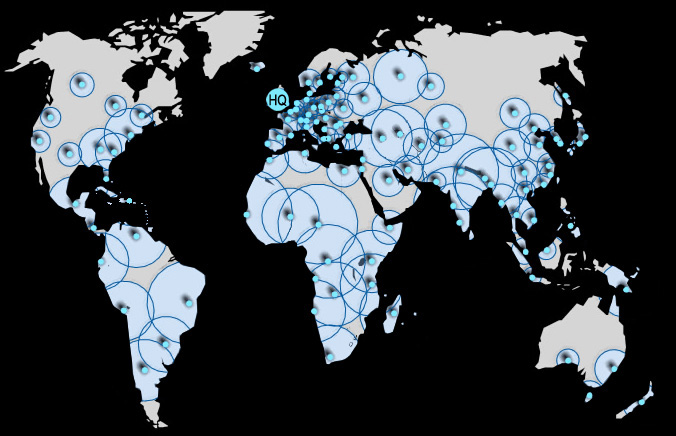
The rings around the plants represent their production capacities based on the demand for AIDS treatment in that region, not the geographic region they serve. Because of the ever-changing world populations, and the spread of AIDS (reaching and affecting new and different populations as time passes, see this animation which maps the history of the virus's spread), these manufacturing plants' capacities will be easily altered by the detachability of and stackability of these resources that come from London.
These plants will subtly infiltrate the cities in which they are located, as shown below (see conceptual collage from previous post). They are subdivided into "wellness pods" which are small pods containing necessities for treating AIDS that can be transported to other cities as well as the most remote of areas. The animation shows one of these pods travelling to a remote area outside of the manufacturing city.
Here are a couple renderings of the system:


For the purposes of this project, I will be zooming in and focusing on Cape Town, South Africa and its surrounding region. One reason I am focusing here is that it is a good example of a town that produces AIDS treatment but sells it elsewhere, so that its own citizens do not receive the treatment (notice that it is not part of the megaContinent). Another reason is that the area that it is not serving has some of the highest prevalence of AIDS in the world, and therefore the highest demand for the drugs.

Here are a couple collages that put the model in the context of Cape Town.

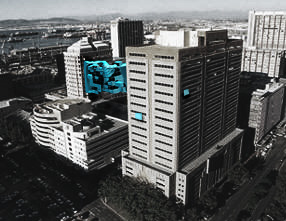
These wellness pods will serve a few functions - one of which will be the transport of drugs, treatment and equipment, particularly to remote areas (shown below).

There is also the possibility of a new way of looking at hospiss care - GSK's wellness pods extending to those who can afford a more comfortable treatment system in their home.

While this concept could be applied to a world of diseases, not just AIDS, for the purposes of this project I am focusing on AIDS because only GSK produces AIDS treatment drugs, and this concept is based through that company, which is headquartered in London, England.
I'll start from the largest scale, and work my way down. The HQ of GSK will be an entire city of parts to drug manufacturing plants (located outside of London), to be detached and transported to the manufacturing plants and locations in the map below (from the previous post).

The rings around the plants represent their production capacities based on the demand for AIDS treatment in that region, not the geographic region they serve. Because of the ever-changing world populations, and the spread of AIDS (reaching and affecting new and different populations as time passes, see this animation which maps the history of the virus's spread), these manufacturing plants' capacities will be easily altered by the detachability of and stackability of these resources that come from London.
These plants will subtly infiltrate the cities in which they are located, as shown below (see conceptual collage from previous post). They are subdivided into "wellness pods" which are small pods containing necessities for treating AIDS that can be transported to other cities as well as the most remote of areas. The animation shows one of these pods travelling to a remote area outside of the manufacturing city.
Here are a couple renderings of the system:


For the purposes of this project, I will be zooming in and focusing on Cape Town, South Africa and its surrounding region. One reason I am focusing here is that it is a good example of a town that produces AIDS treatment but sells it elsewhere, so that its own citizens do not receive the treatment (notice that it is not part of the megaContinent). Another reason is that the area that it is not serving has some of the highest prevalence of AIDS in the world, and therefore the highest demand for the drugs.

Here are a couple collages that put the model in the context of Cape Town.


These wellness pods will serve a few functions - one of which will be the transport of drugs, treatment and equipment, particularly to remote areas (shown below).

There is also the possibility of a new way of looking at hospiss care - GSK's wellness pods extending to those who can afford a more comfortable treatment system in their home.

Subscribe to:
Comments (Atom)








